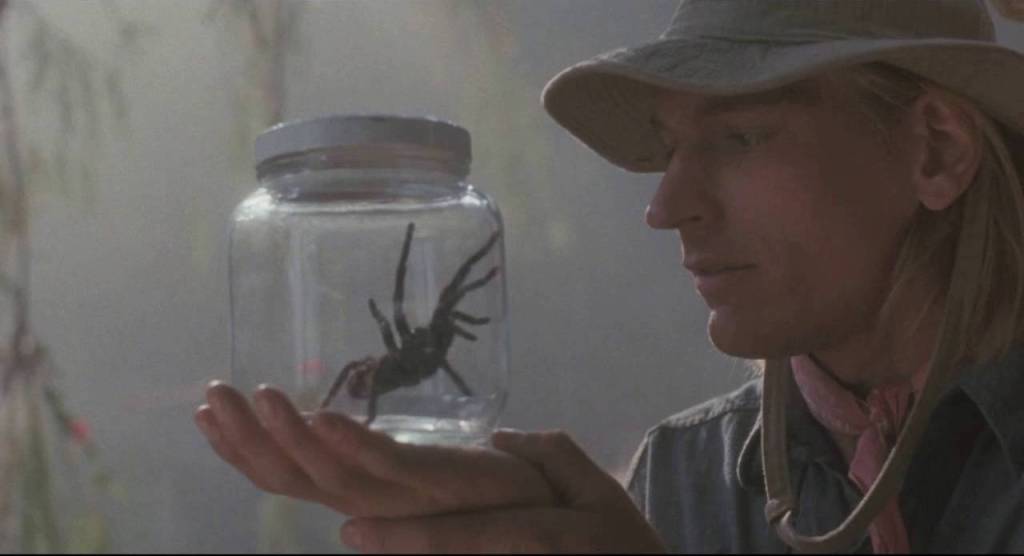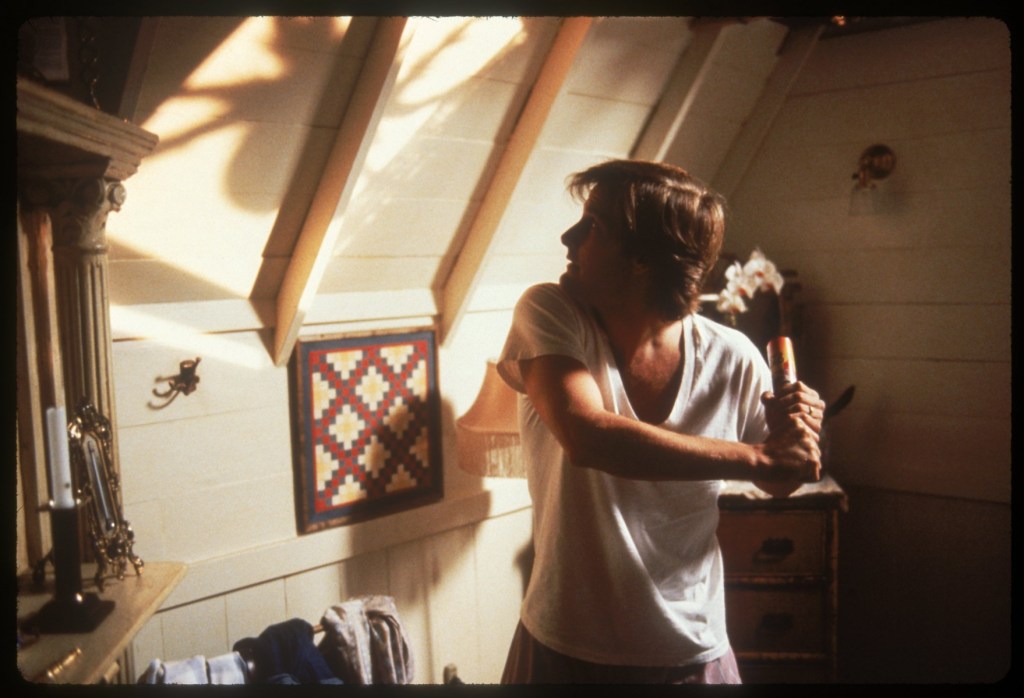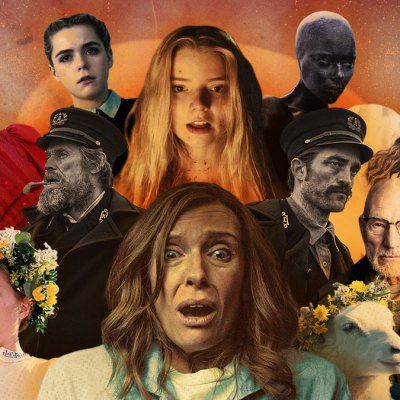How Arachnophobia Became the Perfect Creepy Crawly Horror Comedy
Frank Marshall pulled off an impressive balancing act in making Arachnophobia both scary and funny – but it was no easy feat, as screenwriter Wesley Strick tells us, 30 years on.
There’s a moment in Arachnophobia where Jeff Daniels’ Dr Ross Jennings, lying in bed one night worried his new hometown of Canaima is under attack from venomous spiders, spots an eight-legged intruder lurking in plain sight on his bedroom wall. The scene builds to a terrifying crescendo when the panic-stricken Jennings, who has a pathological fear of spiders, decides to confront the arachnid – only to discover it’s a coat hook.
It’s a prime example of the power Arachnophobia still possesses, 30 years on from its release. The power to have audiences breaking out in cold sweats one minute and fits of laughter the next.
The story of an ordinary American town that becomes infested with a deadly new species of spider unwittingly transported over from the Amazon rainforest, Arachnophobia might have been a very different prospect in the hands of another filmmaker.
Fortunately, Arachnophobia had Frank Marshall at the helm.
A long-time producer who had worked with everyone from Orson Welles to Martin Scorsese prior to founding Amblin Entertainment with his wife Kathleen Kennedy and long-time collaborator Steven Spielberg, Arachnophobia represented Marshall’s directorial debut. In many ways, he couldn’t have picked a better project.
Never work with animals and children
While the old Hollywood adage claimed you should never work with children or animals, Marshall had an impressive track record with both – especially animals. He had overseen the uses of several snakes in Raiders of the Lost Ark as well as Indiana Jones and the Temple of Doom and orchestrated the plague of rats that pop up in the sewers of Venice during Indiana Jones and the Last Crusade.
More importantly, like Spielberg, he wasn’t averse to cranking up the PG scares whether it be a melting Nazi or the desiccated corpse of a spider bite victim. The key to cooking up a scare in Arachnophobia, however, were the arachnids themselves.
Marshall and his production team auditioned a variety of spiders for the film, whittling it down to a shortlist of four distinct species, including wolf spiders, tarantulas, and huntsman spiders.
“I held what I called the Spider Olympics,” he explained in an interview with Amblin. “I really put them through their paces to see if they could climb a glass, if they looked scary, to see how big they were or if they looked good on camera and how we could motivate them.”
He eventually settled on three-inch wide Delena spiders; a huntsman arachnid native to Australia that had arrived in New Zealand in the 1920s.

Hundreds of little Marlon Brandos
Over 300 were shipped to the US for filming, with more arachnids added as filming continued.
“We had a spider condominium where we had different drawers with spiders that could climb better than others and some that were faster than others. It was really a science of different spider actors.”
A variety of techniques were used to direct the spiders. Hot and cold air proved effective while the crew also hit on the use of Lemon Pledge cleaner to help guide their movements.
In some of the more complex shots, microscopic leashes and tiny steel plates were used but even they had their limitations. Even so, takes regularly ran into the double digits with the film’s arachnid performers guilty of going off script like a bunch of eight-legged Marlon Brandos.
Sometimes things went like clockwork, like the scene where spiders begin to burst out of a bathroom sink.
“We blew hot air and they came bursting out of the drain,” Marshall said. “I never dreamed they would just explode.”
Other times, however, it proved difficult, with the director citing the scene in which the town coroner and his wife are offed when a rogue arachnid gets inside their bowl of popcorn.
Marshall said: “The popcorn was probably the hardest one and in the shot that we got, the spider comes out and we follow it. That’s all ad-libbed by the spider.”
It required meticulous planning on Marshall’s part and a wealth of patience from stars like Daniels, who acknowledged to the New York Times that it took a “special kind of actor” to work with spiders. It was all worth it though.
The practical approach proved crucial, imbuing Arachnophobia with a sense of realism and a timeless quality missing from the many CGI-led spider monstrosities that have followed in the years since. Not that Marshall was averse to a little technical wizardry though.
While a real-life Amazonian bird-eating tarantula was cast as larger spider credited as “The General” in the movie and known as “Big Bob” on set, Marshall knew the arachnid was neither big enough for some of the film’s stunts nor trained enough to pull off many of the film’s crucial scenes – including any and all close-ups.
Instead, a 15-inch mechanical spider was built in his place by then-rookie special effect whizz Jamie Hyneman, who would go on to find fame on the TV series Mythbusters.
While the handling of the spiders was crucial, Marshall also understood the importance of grounding Arachnophobia in reality was equally important. That required two crucial elements: good casting and relatable set pieces.
Killer casting
One of Arachnophobia’s strengths lies in the fact the film takes the time to establish characters and setting before tearing the whole thing apart with a childlike glee. For Marshall, setting out the stall of the movie was crucial to cranking up the scares – and the fun.
“What’s important in all of these movies is you’ve got to care about the characters,” he told Amblin. “I tried to cast really great actors in the character parts and the smaller parts. I did feel it needed a little bit of comic relief in this story because it was going to be so creepy.”
Populating the town’s doomed cast of characters with seasoned performers like Henry Jones and Mary Carver as well as comedic actors like Stuart Pankin and Peter Jason proved a masterstroke and ensured, by the time the spiders were closing in, you actually cared for their safety. When the arachnids did descend, it was often to disrupt an otherwise familiar scene of life in small town USA: a garden party, a night in watching Jeopardy or a football practice. In another nightmarish set piece, the town’s soon to retire doctor is bitten by a spider hiding in his slippers.
“I thought what’s scariest to people is everyday common things that we all would freak out by,” Marshall said. “I know that every morning when I get up to put on my slippers, I still shake them off.”
In the wrong hands, Arachnophobia could easily have become a straightforward enough horror movie – and, for a brief period at least, it was. According to Jeff Daniels, when he first signed on the film was a far more serious affair.
“You could tell that the lines were kind of written by computer,” he told the Philadelphia Daily News.
With time ticking on both Daniels and Marshall eager for the film to have a streak of black comedy running through it, producer Kathleen Kennedy went in search of help. In December of 1988, she found it in Wesley Strick.

Low-hanging fruit
By then filming had already begun on the movie, with work complete on all of the scenes charting photographer Jerry Manley’s horrifying death at the hands of a spider in the jungles of Venezuela and subsequent transportation back to the US with an arachnid in tow.
Strick had been working with Spielberg on the script for a remake of Cape Fear. When he got the call from Kennedy, he was settling in for a quiet Christmas with his wife and young children. He didn’t know it yet, but Christmas was about to be cancelled.
“Kathleen called and asked: ‘do you have holiday plans? Would you be available to work for two or three weeks on a film called Arachnophobia for my husband, Frank Marshall?’ It sounded like fun and I was stuck at home, so I said yeah,” Strick tells Den of Geek.
Arachnophobia had been in development long before Marshall took charge and, with time ticking on, Kennedy felt it would be beneficial for Strick to glance through some of the previous revisions of screenwriter Don Jakoby’s original script. There were quite a few revisions, as it turned out.
“A messenger showed up from Amblin with basically a massive box full of scripts,” Strick says. “I had never seen so many drafts. It had been in development for a long time. She sent me like 12 scripts that had been written over two years.”
Strick immediately identified the issue.
“The early drafts were both funny and horrific. But by the time I got to the draft they were working with I could see they had developed out most of the horror and the humor. This kind of thing happens in development because studios often seek clarity over entertainment. They believe the audience should be spoon-fed everything.”
But without “the horror and the humor” Arachnophobia wasn’t working.
“In this instance, however, the changes had ended up flattening out the plot in an effort to make the story clear,” Strick says. “They forgot that it also needed to be funny and scary. In these prolonged development situations, people kind of lose focus on what it is they are really trying to do while trying to solve very literal problems. That’s why it’s beneficial to have another writer come in with a fresh eye. Someone who hasn’t been worn down by two years of search and can fix what got broken by accident.”
Something else that jumped out at him too – nobody in the script had arachnophobia.
“That struck me as a huge missed opportunity,” he says. “It was such low-hanging fruit. I started to question my own sanity like, how could they have missed that? So, I called Frank and Kathleen and said ‘hey nobody has arachnophobia; do you not think Ross Jennings should have arachnophobia? And they were both quiet and just kind of said ‘well do you?’ and I said ‘Yeah’ and they were like ‘well go do that’”
While Strick acknowledges such changes come off as “screenwriter 101 stuff”, the decision to make Jeff Daniels’s character an arachnophobe proved crucial in tying the plot together.
Read more
“It helps the movie a lot. It became the dramatic arc of the story,” Strick says. “Things like the moment, early in the film, when Dr Jennings recalls how he became an arachnophobe after a spider crawled up his body as a child. That plays out again in the final act, when he’s pinned down and ‘the general’ is crawling over him. He’s forced to overcome that primal fear. Those moments play great and provide the spine of the picture. Without it, I don’t know how the story would play. It would be a series of set pieces. Maybe that would have been good enough but it’s hard to imagine it without that through line.”
Strick’s role was also to reinvigorate some of what had been lost in the multiple drafts, in an editing process known as “punching up.” The screenwriter and script doctor explains it perfectly in the context of Arachnophobia.
“With a film like this, you were essentially building a ride at a theme park,” he says. “You want to deliver thrills so there needs to be a forward momentum to it. It can’t meander. The dialogue has to crackle. That’s how movies entertain. I am always looking to focus scenes. Often, you read lots of scenes that are fine and have a clear point, but the dialogue isn’t focused. That’s where polishing comes in. It’s looking at every single line and making sure it’s right down to the number of syllables. With Arachnophobia, I had to liven it up. Add some energy and a bit of humor.”
Over the course of three weeks, Strick worked in a garage converted into a makeshift office, “punching up” the script.
“There was a lot of pressure because it was already in production but I had a sense of what was needed,” he said. “Even so, it was a little dicey. There was a lot hanging on it.”
Good times and Goodman
Both Kennedy and Marshall were thrilled with the changes Strick made. It struck a chord with Marshall’s desire to make Arachnophobia more like a ghost train ride at an amusement park than a night in a haunted house.
“I liked his dialogue and he wrote creepy scenes,” Marshall later told Amblin. “I thought that was fun… he wrote good characters.”
Daniels echoed that sentiment, explaining to the Orlando Sentinel how the fresh injection of comedy helped the film ebb and flow.
“We approached it as a comedy with a couple of thrills,” he said. “We knew we had the thrills in there, so we worked hard to make sure the movie had a sense of humour about itself.”
The humor, he said, “kind of relaxes the audience, so that we can come in and get them again.”
Strick ended up staying involved in the project, albeit in a removed capacity – Marshall would occasionally phone him from the set to bounce around ideas. Whether he can be credited for John Goodman’s performance is up for debate, though he did write several of his lines. Goodman’s cameo remains a source of some contention among Arachnophobia fans. Riding high off the success of Roseanne at the time, it was Spielberg who suggested Goodman appear as exterminator Delbert McClintock.
Marshall had been eager to inject some humor into the proceedings but Goodman’s exaggerated performance – supposedly based on a real-life exterminator he knew and an old science teacher – jars with the straight-faced approach seen elsewhere.
Testing and Box Office
Not that it mattered all that much to movie-goers.
“I went to a few test screenings and the whole audience would be shrieking and just generally reacting,” Strick says.
Those test screenings did pick up one issue though, the original ending, which saw the film conclude immediately after the spider nest is destroyed, fell flat. It was Strick who came up with the idea of showing that the family had moved back to San Francisco.
“They wanted something they could shoot in one day. It had to be simple.”
Billed as the first “thrill-omedy” – a term widely ridiculed by the press at the time – Arachnophobia went on to enjoy modest success at the box office, drawing $53.2 million off a budget of $22 million.
Strick has his own theory for why the film underwhelmed.
“I remember my younger sister, Charlotte, told me she couldn’t see it because she was too scared of spiders. I realized a lot of women felt like that. They say when couples go to the movies it’s the female that picks the movies. I’m not sure if that’s true but that’s gospel in Hollywood. I worried that if women were afraid to see it men wouldn’t either.”
In any case, like many films of the era, Arachnophobia went on to enjoy a second life on video, helped by some standout scares that proved popular with the rewind/slow-motion generation of VHS hounds.
Remake
While Strick tends to avoid revisiting his own work, he was pleasantly surprised when rewatching Arachnophobia.
“I was reluctant to watch it again in case it was a relic of another era of Hollywood but it’s still loads of fun,” he says. “My wife was jumping and shrieking and she’s the ideal audience because she’s terrified with spiders. It’s a very funny movie and yet a lot of people die.”
With talk of a potential remake on the way, Strick has one bit of advice: “Don’t do it”.
“I don’t especially see how or why they would need to remake it for a modern audience. There is something timeless about the original and the way we made it.”
30 years later, Arachnophobia remains a true one-off. A film equal parts horror and comedy and one that would fall flat if either side hadn’t been up to muster. In that sense it’s wholly unique and might be better off staying that way.

